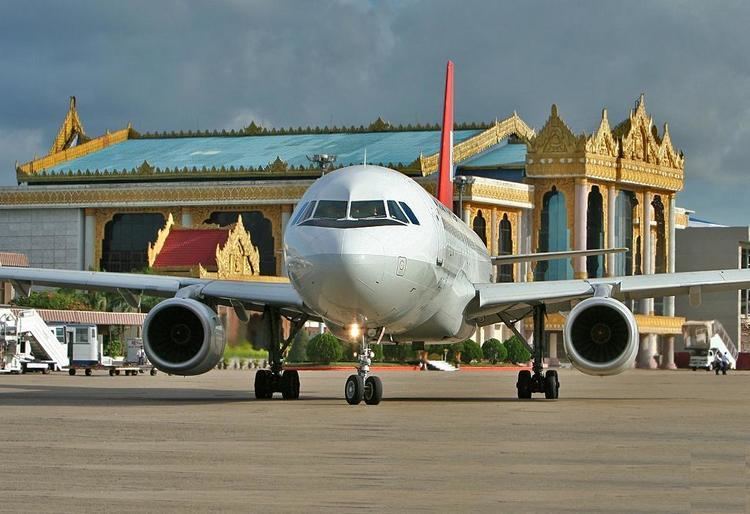Airport type Public Website www.yangonairport.aero Code RGN Phone +95 1 533 0316 | Elevation AMSL ft / 33 m 3,414 Asphalt Elevation 33 m | |
 | ||
Address Yangon Airport Rd, Yangon, Myanmar (Burma) Owner Government of the Republic of Union of Myanmar Hub for Air Bagan, Air KBZ, Air Mandalay, Asian Wings Airways | ||
Yangon international airport myanmar burma
Yangon International Airport (Burmese: ရန်ကုန်အပြည်ပြည်ဆိုင်ရာလေဆိပ်; MLCTS: Yan Gon a pyi pyi hsai ya hlay hsate [jàɴɡòʊɴ əpjìpjì sʰàɪɴjà lèzeɪʔ]) (IATA: RGN, ICAO: VYYY) is the primary and busiest international airport of Myanmar. The airport is located in Mingaladon, 15 kilometres (9.3 mi) north of downtown Yangon. All ten Burmese carriers and about 30 international airlines operate at Yangon International.
Contents
- Yangon international airport myanmar burma
- New terminal 1 at yangon international airport myanmar
- History
- Modernization
- Terminal 1
- Terminal 2
- Terminal 3
- Guard of Honor Building VIP Terminal
- References
New terminal 1 at yangon international airport myanmar
History
During World War II, the airfield was called RAF Mingaladon and served as an operating base for fighter aircraft such as No. 60 Squadron RAF from February 1941 to February 1942 flying Bristol Blenheim I, No. 67 Squadron RAF from October 1941 to March 1942 flying Brewster F2A Buffalo and Hawker Hurricane IIs, No. 135 Squadron RAF from January–February 1942 flying Hawker Hurricane IIs, No. 681 Squadron RAF from June to September 1945 flying Supermarine Spitfire and the 3rd Squadron, 1st American Volunteer Group (Flying Tigers) of the Chinese Air Force flying Curtiss P-40s. There was also a Communication Flight of the Burma Volunteer Air Force equipped with Tiger Moths and Westland Lysanders and anti-aircraft support for the airfield was provided by members of the 12th Burma Rifles. The airport was built on the former World War II airfield RAF Mingaladon in 1947 by the Calcutta Metropolitan Airports Authority. Once regarded as the best in Southeast Asia and the primary airport serving that region, the airport fell into disrepair and remained that way for decades, as new superhubs like Singapore Changi Airport, Bangkok Suvarnabhumi Airport and Jakarta Soekarno-Hatta were built and superseded Yangon's facilities.
Airport capacity was boosted to 6 million passengers per year in early 2016. Currently, there are plans to build a completely new and larger airport, Hanthawaddy International Airport, on a much larger site and somewhat away from Yangon.
Modernization
A modernization program was launched in April 2003 and resulted in a new terminal and an extended 3414 m runway.
Designed by the Airport Development Division of CPG Corporation of Singapore, a new terminal was constructed at a cost of US$13.3 million by Asia World. It can handle 900 arriving and 900 departing passengers simultaneously. The design meets IATA service standards and complies with ICAO safety and security standards at a cost of SG$30 million. Other notable features include:
In June 2011, the government announced plans to expand the airport by 40% and increase its capacity from 2.7 million passengers to 3.8 million passengers annually. The airport was already over its annual capacity of 2.7 million passengers, having accepted 3.1 million in 2012 and 4 million in 2014. To fulfill this increased demand, new international and domestic terminals are being constructed and are expected to be finished end of 2016. After upgrading, Yangon International Airport will be able to service 6 million passengers annually.
In 2013, a contract worth $150 million was awarded to a consortium led by an affiliate of Asia World to construct a new domestic terminal and expansion of airport apron.
The new international terminal (T1) opened in March 2016, with the previously existing international terminal being designated as T2. The new domestic terminal (T3) opened on December 5, 2016.
Terminal 1
In August 2014, the old domestic terminal was demolished and construction began for the new six-story Terminal 1 which will handle international flights. The opening ceremony was held on March 12, 2016. After the opening of Terminal 1, the airport can handle 6 million passengers annually, as opposed to 2.7 million before.
Terminal 2
After the opening of Terminal 1, the former International Terminal was renamed "Terminal 2." The building was designed by the CPG Corporation of Singapore and constructed by the Asia World Company costing USD $13.3 million. The terminal can handle 900 arriving passengers and 900 departing passengers at the same time.
Terminal 3
Terminal 3, which is used for domestic flights, opened on December 5, 2016, replacing the old domestic terminal which was demolished in August 2014.
Guard of Honor Building (VIP Terminal)
The former VIP terminal was temporarily being used as the domestic terminal, until Terminal 3 was completed. The VIP terminal will be converted to a connector between Terminal 1 and Terminal 2.
